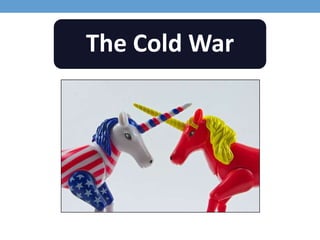
The Cold War PPT
- 1. The Cold War
- 2. I. The Post-War World (1945-1949) II. Communism in Asia (1949-1953) III. The Khrushchev Era (1955-1964) IV. The Brezhnev Era (1964-1985) V. The Fall of Communism (1985-1992) Outline
- 3. I. The Post-War World The United Nations • Fifty nations send delegates to San Francisco to draft the “Charter of the United Nations” in 1945 • Five permanent members: United States, Great Britain, the Soviet Union, China, and France • Designed to promote international cooperation and peace
- 4. The Soviet Bloc Communism in Eastern Europe • Red Army’s presence in Eastern Europe allows Stalin to establish Communist governments in Poland, Rumania, Bulgaria, Hungary, Yugoslavia, Albania, and Czechoslovakia • Ensured that there were friendly governments on borders • Mutual defense treaty, Warsaw Pact “The Iron Curtain” • Churchill gives speech in 1946 at Fulton, Missouri • Declares “From Stettin in the Baltic to the Trieste in the Adriatic, an iron curtain has descended across the continent”
- 6. Democracy CommunismVS. “A War of Ideology”
- 7. Post-War Germany Occupation Zones in Germany • Post-War Germany is split up into occupation zones • Berlin split into four occupation zones; Western powers had access through Eastern Germany to Berlin The Berlin Blockade • Soviet Union creates the Berlin Blockade in • Berlin Airlift used by the U.S. to send supplies • Soviets end blockade in 1949 • Western nations found Federal Republic of (West) Germany • Soviets create the (East) German Democratic Republic
- 9. Containment U.S. Policy Against Communism • Domino effect/domino theory • The Truman Doctrine: United States provides assistance to Greece and Turkey to fight against Communist rebels • The Marshall Plan: Provision of $13 billion for the economic restoration of Europe; European Recovery Program The Establishment of NATO • Military alliance for Western Countries • In 1949, twelve nations meet to sign the North Atlantic Pact, establishing the North Atlantic Treaty Organization (NATO)
- 10. II. Communism in Asia The Cold War in China • Soviet Union gives support to Communists, led by Mao Zedong • United States supports Nationalists led by Chiang Kai-Shek • Nationalists retreat to TAIWAN, Mao forms the People’s Republic of China in 1949 Pre-War Korea • Yalta Conference grants North Korea to the Soviets • Communist government led by Kim Il-Sung • United States supports South Koreans, led by Syngman Rhee • Occupying powers withdraw in 1949
- 11. The Korean War Initial North Korean Attacks • North Korea invades in 1950 • Americans and S. Koreans surrounded at the Pusan Perimeter • General MacArthur conducts landing at Inchon; destroys majority of North Korean army in the South Stabilization of the Front • South Korean forces approach China; Chinese join the fight • Chinese troops push Americans and S. Koreans out of N. Korea • MacArthur dismissed for protesting against limited war • UN armies stabilize front near 38th Parallel in 1953
- 13. The Vietnam War Pre-War Vietnam • Ho Chi Minh declares independence, defeats French in 1954 • Anti-communist Ngo Dinh Diem wins power in the South • Gulf of Tonkin Incident: USS Maddox attacked by NV PT boats • Lyndon B. Johnson declares war in 1964, United States Involvement • Operation Rolling Thunder: Bombing of supply lines • Military drafting imposed by US increases • Tet Offensive by NV, political and strategic victory • Protests against war in US, “Vietnamization”
- 16. III. The Khrushchev Era Tension in Europe • Nikita Khrushchev rises to power in 1955, calls for “peaceful coexistence” between Russia and the West; “The Thaw” • Demands demilitarization of Germany; request ignored • U-2 incident; Khrushchev breaks up the Paris Summit in 1960 • Berlin wall constructed in early 1961 Castro in Cuba • In 1959, Fidel Castro (assisted by Che Guevara) overthrows Fulgencia Batista, a US supported dictator; United States breaks diplomatic relations • CIA begins to train Cuban exiles to oust Castro
- 18. Mutually Assured Destruction ICBM: Inter-Continental Ballistic Missile ABM: Anti-Ballistic Missile
- 19. The Cuban Missile Crisis Bay of Pigs Invasion • Plan approved by new president John F. Kennedy • 1,500 Cuban exiles invade in 1961; crushed in three days • Castro declares himself a Marxist; allies with Soviet Union Nuclear Missiles in Cuba • Soviets send weapons and missiles to Cuba in May 1962 • On Oct. 22, Kennedy demands removal of missiles • Khrushchev demands removal of missiles from Turkey • Crisis resolved on Oct. 28; closest to nuclear war
- 21. IV. The Brezhnev Era Changes in the Soviet Union • Leonid Brezhnev (1964-1982): undoes reforms by Khrushchev, “refreezes”, deteriorates relations with China Détente and Treaties • Détente: a relaxing of tension, as by negotiations or agreements • Nuclear Non-Proliferation Treaty and Outer Space Treaty (1960s) • SALT I (1972): Froze existing numbers of ICBMs, limits on ABMs • SALT II (1979): Banned new missile programs, effective • Ends when USSR invades Afghanistan in 1979 • Korean Air Lines Flight 007 shot down in 1983, killing 269
- 23. V. The Fall of Communism The Gorbachev Era • Mikhail Gorbachev (1985-1991): three major reforms • Glasnost: “openness”; less cultural repression • Perestroika: “restructuring”; economic reforms • Democratization: opening of the political system Revolution and Independence (1989) • Romania, Czechoslovakia, and Hungary become democracies • Trade union Solidarity demands government recognition; Communists give in and hold free elections • Chinese put down democratic protests at Tiananmen Square
- 24. Fall of the Soviet Union • Boris Yeltsin criticizes slow reforms, gains popularity • Elected as first president of the Russian Republic in 1991 • Halts coup by hardline Communists, gains support • Ex-Soviet states form the Commonwealth of Independent States • USSR dissolves on December 26th, 1991 German Reunification • Protestors in East Germany demand opening to West Germany • Leader of East Germany appeases protestors • Berlin Wall falls in 1989 Germany and the USSR
